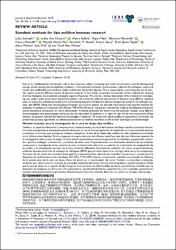| dc.contributor.author | Svecnjak, Lidija | |
| dc.contributor.author | Chesson, Lesley Ann | |
| dc.contributor.author | Gallina, Albino | |
| dc.contributor.author | Maia, Miguel | |
| dc.contributor.author | Martinello, Marianna | |
| dc.contributor.author | Mutinelli, Franco | |
| dc.contributor.author | Waters, Todd Alan | |
| dc.contributor.author | Muz, Mustafa Necati | |
| dc.date.accessioned | 2022-05-11T14:42:20Z | |
| dc.date.available | 2022-05-11T14:42:20Z | |
| dc.date.issued | 2019 | |
| dc.identifier.issn | 0021-8839 | |
| dc.identifier.issn | 2078-6913 | |
| dc.identifier.uri | https://doi.org/10.1080/00218839.2019.1571556 | |
| dc.identifier.uri | https://hdl.handle.net/20.500.11776/9339 | |
| dc.description.abstract | Due to its multifunctional and complex role in the honey bee colony functioning and health (construction material allowing food storage, brood rearing, thermoregulation, mediation in chemical and mechanical communication, substrate for pathogens, toxins and waste), Apis mellifera beeswax has been widely studied over the last five decades. This is supported by a comprehensive set of scientific reports covering different aspects of beeswax research. In this article, we present an overview of the methods for studying chemical, biological, constructional, and quality aspects of beeswax. We provide a detailed description of the methods for investigating wax scales, comb construction and growth pattern, cell properties, chemical composition of beeswax using different analytical tools, as well as the analytical procedures for provenancing beeswax and beeswax-derived compounds based on the hydrogen isotope ratio (IRMS). Along with classical physico-chemical and sensory analysis, we describe more precise and accurate methods for detection of adulterants in beeswax (GC-MS and FTIR-ATR). Moreover, we present methods for studying the influence of beeswax (comb foundation) adulteration on comb construction. Analytical protocols for determining the pesticide residues using different chromatographic and spectroscopic techniques are also described. As beeswax is an agent of high risk for the transmission of bee diseases, we present methods for detection of pathogens in beeswax. To ensure the reproducibility of experiments and results, we present best practice approaches and detailed protocols for all methods described, as well as their advantages and disadvantages. | en_US |
| dc.description.sponsorship | COST ActionEuropean Cooperation in Science and Technology (COST) [FA0803]; Ricola Foundation - Nature Culture | en_US |
| dc.description.sponsorship | We would like to acknowledge the Ricola Foundation - Nature & Culture, and COST Action FA0803 for funding the COLOSS (Prevention of honey bee COlony LOSSes) network and making the BEEBOOK possible. We would also like to express our gratitude to Editor Vincent Dietemann for his kind support all the way, and for providing helpful and constructive suggestions. | en_US |
| dc.language.iso | eng | en_US |
| dc.publisher | Taylor & Francis Ltd | en_US |
| dc.identifier.doi | 10.1080/00218839.2019.1571556 | |
| dc.rights | info:eu-repo/semantics/openAccess | en_US |
| dc.subject | Apis mellifera | en_US |
| dc.subject | beeswax | en_US |
| dc.subject | wax scales | en_US |
| dc.subject | comb construction | en_US |
| dc.subject | cell properties | en_US |
| dc.subject | chemical composition | en_US |
| dc.subject | beeswax provenancing | en_US |
| dc.subject | adulterants | en_US |
| dc.subject | pesticide residues | en_US |
| dc.subject | pathogens | en_US |
| dc.subject | Ionization Mass-Spectrometry | en_US |
| dc.subject | Performance Liquid-Chromatography | en_US |
| dc.subject | Temperature Gas-Chromatography | en_US |
| dc.subject | Solid-Phase Extraction | en_US |
| dc.subject | Honey-Bee Colonies | en_US |
| dc.subject | Comb Wax | en_US |
| dc.subject | American Foulbrood | en_US |
| dc.subject | Acaricide Residues | en_US |
| dc.subject | Bacillus-Larvae | en_US |
| dc.subject | Infrared Spectroscopy | en_US |
| dc.title | ( Standard methods for Apis mellifera beeswax research) | en_US |
| dc.type | review | en_US |
| dc.relation.ispartof | Journal of Apicultural Research | en_US |
| dc.department | Fakülteler, Veteriner Fakültesi, Klinik Öncesi Bilimler Bölümü, Parazitoloji Ana Bilim Dalı | en_US |
| dc.authorid | 0000-0003-2903-9390 | |
| dc.authorid | 0000-0001-5540-318X | |
| dc.authorid | 0000-0001-9464-8286 | |
| dc.authorid | 0000-0002-7833-8891 | |
| dc.authorid | 0000-0001-9811-6308 | |
| dc.authorid | 0000-0002-2215-5682 | |
| dc.identifier.volume | 58 | en_US |
| dc.identifier.issue | 2 | en_US |
| dc.institutionauthor | Muz, Mustafa Necati | |
| dc.relation.publicationcategory | Diğer | en_US |
| dc.authorscopusid | 25825602700 | |
| dc.authorscopusid | 6506709721 | |
| dc.authorscopusid | 26530977800 | |
| dc.authorscopusid | 7005342470 | |
| dc.authorscopusid | 8526571500 | |
| dc.authorscopusid | 7003961760 | |
| dc.authorscopusid | 23111045300 | |
| dc.authorwosid | MUTINELLI, FRANCO/K-7525-2018 | |
| dc.authorwosid | Nunes, Fernando M./B-3003-2012 | |
| dc.authorwosid | Was, Ewa/T-8979-2018 | |
| dc.authorwosid | Martinello, Marianna/AAE-3863-2021 | |
| dc.identifier.wos | WOS:000465444200003 | en_US |
| dc.identifier.scopus | 2-s2.0-85063231268 | en_US |



















